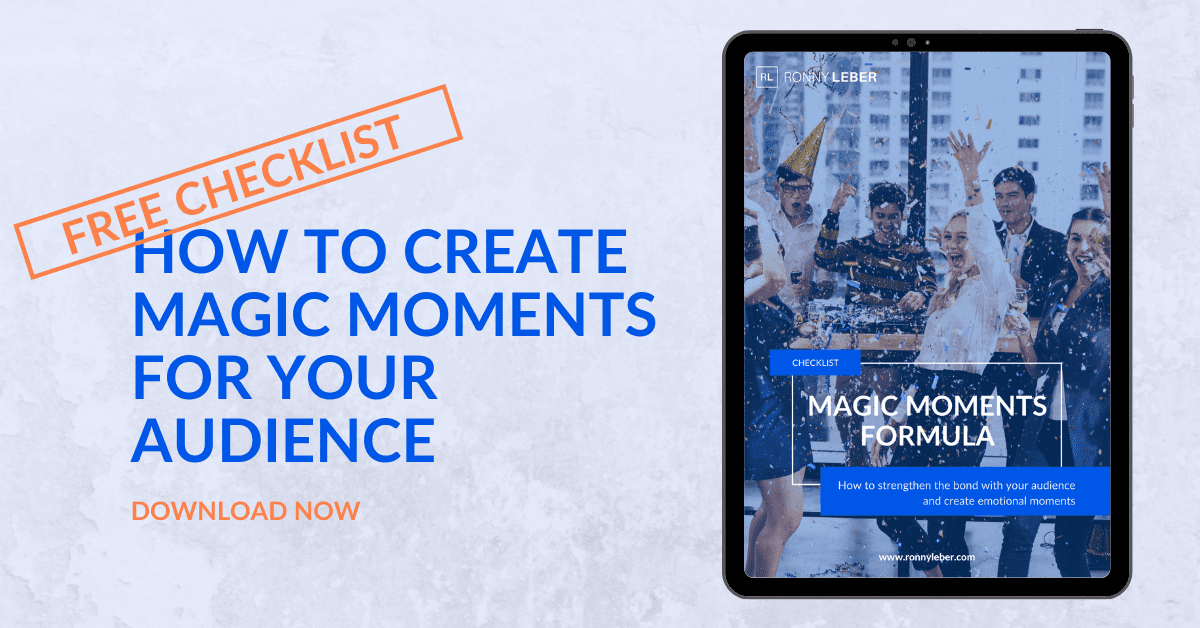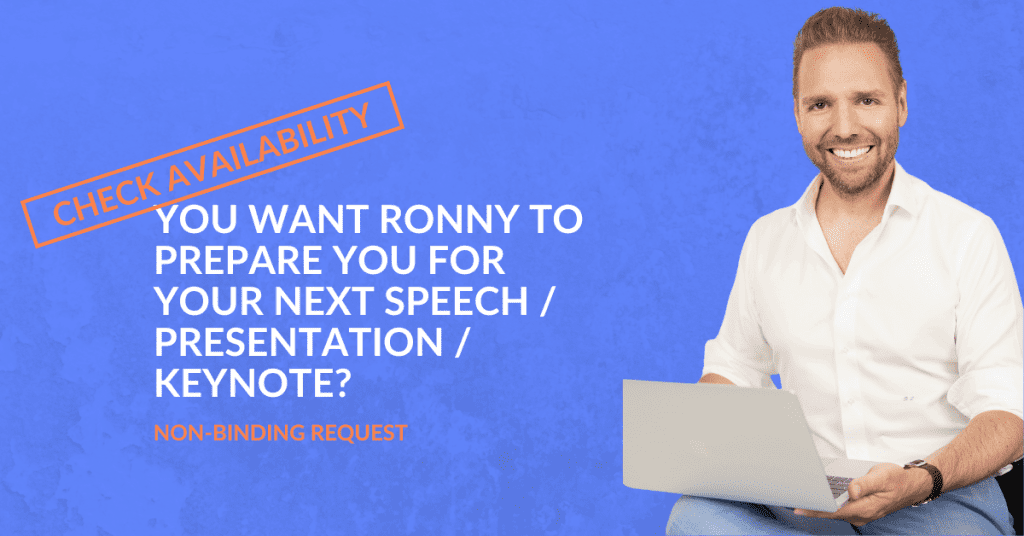Persuasive presentation: In 3 steps to your ideal state to inspire your audience
You don’t need nerves of steel to hold an audience spellbound. In this article, you’ll learn how to get yourself in the ideal state for your persuasive presentation. From my decades of experience as a TV presenter, event host as well as a keynote speaker, I’ve learned one thing: if you want to ignite a spark in others, you have to be on fire first.
That means you have to get yourself in the right emotional state to do so. And that’s what this post is all about. Of course, you can use this guide for other situations as well.
"If you want to ignite a spark in others, you have to burn first! That means that you need to get yourself in the right emotional state for a persuasive presentation." Share on X
Stop guessing how to WOW your audience!
We will send you our secret ingredients to WOW your audience for free! In the MAGIC MOMENTS FORMULA you can learn how to take any audience of any size and create a deep emotional experience for them in order to create a deeper emotional bond with you and your brand.
Why is the ideal state important?
For many things in life, 20% is the right strategy, while 80% is psychology. Accordingly, the key point is that we are masters of our emotions. This is all the more important when it comes to a subject that, according to surveys, is feared more than death: speaking in front of other people.
When you are in your ideal state, you can move mountains. You radiate stage presence and can inspire your audience from your own power. There’s no need for technical bells and whistles or an elaborate stage set. You can take your audience on a journey from A to B. In your ideal state, you are the magician who creates Magic Moments and ignites the fire in your audience. When you reach your ideal state, you are in your full power.
When is the ideal state important?
Whenever you want to achieve something with your audience – whether it is simply to make your audience understand your big idea or make a persuasive argument – the ideal state is the basic prerequisite for your impulses to ignite. Compare it to an Olympic athlete who has to perform at his best on day X in order to be successful. Exactly the same applies to you when you present in front of an audience.

Maybe you are an entrepreneur and want to prepare your staff for the long needed transformation at the next kick-off event . Or maybe you want to use the next award show to draw attention to your company to get more clients, or simply to get the staff in the mood for the next year at the next teambuilding event or the company Christmas party … If you manage to make the best version of yourself available on the day of your speech, then you will also be able to make your vision tangible and get your audience’s attention. That is true for business presentations or any kind of persuasive presentation.
Or maybe you want to make a name for yourself as a motivational speaker and are at the start of your career. The better you manage to catapult yourself into your ideal state before your presentation, the more convincing your speech will be and the more confident, engaging and authentic you can deliver and inspire your audience.
By the way: the ideal state is also a secret recipe on how to get over stage fright and speech anxiety.
What is the ideal state?
In order to give a persuasive presentation in the ideal emotional state, you need three components. However, a warning right away: the comparison with the Olympic champion also applies here – if you have not trained or practiced in advance, then you can be in such a good emotional state during your presentation that it will only be of limited help. This would be analogous to a sprinter who takes part in the 100m race, feels great, but has never stood on a tartan track before…

To be able to perform at your best on day X and get the most out of your personal performance, you need to practice regularly and with perseverance. I’ve been practicing my ideal state day after day for more than 20 years.
The ideal state is a combination of
- your body,
- directed attention as well as
- internal and external communication.
However, before we take a closer look at the ideal state and how it works in real life, let’s take a look at the ideal preparation so that you can use your state in the best possible way during your persuasive presentations.
The 3 phases of preparation to present with persuasion
The three phases of preparation can be applied to all categories and all subjects. This section is intended to give you an idea on how to best prepare to make a persuasive performance in order to inspire your audience.
1. The preparation for the season
In order to achieve this optimal state at any time, not just at presenting, you need patience and a long preparation phase. Athletes who are training for the upcoming Olympic Games, for example, do not start training 3 weeks before the competition.

Some of these athletes train their whole lives just for this one race. This phase of the preparation usually takes place at the beginning of the season to develop the necessary skills.
Create soft skills, basics and know how
The goal of the “season preparation” is to create the foundations for your success. You build up soft skills, basics and your know-how to be able to perform when it matters. To prepare for a persuasive presentation, you can use voice training, work on your body language and non-verbal communication or one or the other performance coaching, where you work directly with a coach on your basics. Here you can work on presentation techniques and public speaking skills.
In your preparation, your goal is of course essential: if you want to give a keynote, then you should know what makes a good keynote. However, if you also plan to give a virtual presentation or a successful webinar, then you should familiarize yourself with the medium of video and learn how to look professional in front of the camera. In other words, this phase is about laying broad foundations for your persuasive presentation, just as a football team works on basic endurance in preparation for the season, for example, so that they don’t run out of breath later on.
This phase is about drafting your key points, doing your research, figuring out your story and creating persuasive presentation templates that you will define in the next phase.
2. The game preparation
The second phase, game preparation, is about preparing for the next persuasive presentation or stage performance. In sports, this would be preparing for the next game or competition. As a soccer team, the video study of the next opponent would now be on the agenda, as well as everything else worth knowing. In addition, of course, it is still necessary to rehearse appropriate moves to be ready on the day of the competition.
From seminars to corporate presentations – create a persuasive presentation outline
However, if you are working on your presentation skills, then you need to prepare specifically for your persuasive presentation delivery. You need to be very clear about your goal, as well as who your audience is. That is the most important factor in order to be on the same page and to keep up the audience’s attention.
Try to get as much information as possible about your target audience in advance and look for ideas and examples that will inspire your audience. Then you can go through your presentation again to adapt your content and the search for facts, figures and data point by point to your audience – whether at a seminar, at a university or as a presentation in a company. Be clear what arguments the people in the room will raise, what questions might come up, are there any interruptions you might have to adjust to internally, and what solutions you will present.
3. The calm before the storm

The calm before the storm are the hours and minutes before the start. This phase begins the moment the tingling starts. The same applies here as for a competitive athlete: eat light food, drink plenty of water, sleep well the night before and get your nerves under control so that you can then get into the ideal state in the minutes before the race actually starts.
"On the day of your persuasive presentation, it's similar for you as it is for a competitive athlete: eat light, drink lots of water, sleep well the night before and get your nerves under control to get you in the ideal state." Share on XTry to relax, maybe a meditation exercise will help you. Calmly go through your notes and start focusing on your goal. Anyone who has ever watched a ski race on TV has witnessed the racers going over their race in their head just before the start – visualizing – and visualizing their success. The same applies to you: visualize the success and go through your persuasive presentation again in your mind’s eye.
You must love your audience
Then, in the last few minutes before you launch, you should focus only on your audience and the start of your persuasive presentation. You have to love your audience. Build an emotional connection. Any other ideas or questions running through your head at this time should be put aside. It takes an active decision to fully focus on your entire presentation. Make a conscious decision to be successful.
Then comes your starting signal… your time to shine! Use it!
The 3 components of the ideal state for persuasive presentations
Your ideal state consists of 3 components, which interact with each other. If you change only one component, your entire state changes.
1. Your body goes first
The reason I bring up the body component first is because it’s the easiest and quickest to change. Before I go into that, here’s the explanation of what it means and how you can use it in your persuasive presentations.

We humans find it very easy to perceive other people’s emotional states because of the mirror neurons in our brain. That’s why we can see very quickly when someone is ecstatic or sad. The easiest way to see this is by looking at that person’s posture and body language. If the posture changes, the state also changes.
Accordingly, it is up to us, in our compelling presentations, to lead by example and already be in the state we want our audience to be in.
But what is our body component made up of? This is again divided into three parts:
- Body structure
- Movement
- Biochemistry
Body structure and posture
What is your posture? Are your shoulders in a slouched or upright position? What happens to your head position?
Basically, we are bound to our muscular and skeletal characteristics. If we have muscular deficits, for example, and this in turn leads to sloping shoulders or a rounded back, then this can usually only be solved in the medium to long term. Nevertheless, it is important to be aware of your posture and to bring it into a desired position.
Movement
Are your movements dynamic or rather lethargic? How do you move on the stage or in the room? How do you manage to direct the room with your arms?
As a leader, you should move forward dynamically and confidently. Your facial expressions should take your audience on a journey. When you maintain eye contact throughout your persuasive presentation you will get immediate feedback if your message is engaging or if they lose interest.
Biochemistry
Is your breathing shallow or full? Are you well hydrated and have you drunk enough water? Have you slept enough in the last few days?
Everything you have eaten in the last few days affects your biochemistry and therefore your state. Pay attention to what you eat, drink and maybe not eat and drink. Also make sure that you get enough sleep leading up to your presentation.
The body of conviction
So what does convincing body language look like? When you are fully convinced of yourself, you walk upright, shoulders back and head up. Your gaze is focused, your movements dynamic, and your facial expression matched to your emotion. Everything is connected by your body tension.
2. Controlled attention
At any given moment, we can focus on millions of things: Ideas running through our minds, information we are processing, questions that leave answers and solutions open… as well, of course, as external impressions that come at us in that moment – everything we see, hear, feel and sense.

So where should we direct our attention? Our brain constantly asks itself this question – albeit mostly unconsciously. Fortunately, there is something like a filter in our brain: in technical language, this is called the “reticular activating system“. The RAS helps us to make preliminary decisions when focusing. Have you ever noticed that when you wanted to buy something new like a car, a bag, clothes, etc., you suddenly saw this object all the time? Was it suddenly there more often than before? Most likely not. The difference is that your brain suddenly perceived it as important and was looking for it.
Attention that convinces
Now, of course, the question is: where should your attention be when talking to your audience – inside or outside? From my experience, your focus should first be on your goal and then on your audience. Notice your audience and the cues you get from them. Only then can you react flexibly and adapt your planned dramaturgy and content to the moment.
Now we come to the third component.
3. Your communication inside and outside
Words can trigger biochemical reactions. Many of us know it when we hear something about ourselves and suddenly either grow by a few inches or become quite small afterwards. There are words that build us up and words that leave us flabbergasted. How you talk to yourself makes a huge difference. Of course, the same is true in regards of what words you use in communicating with your audience members.
The communication of conviction
Leaders communicate positively – with themselves and their audience. This causes inner muscular tension to be released and you move into a state where endorphins and happy hormones predominate. Try to use the excitement that grips you in a positive way. You will then appear powerful and authentic to your audience.
Design your speech in such a way that you emotionally pick up your audience with words and use transformational vocabulary for this. This means that you can soften negative words and even strengthen positive vocabulary. In this way, you can shape the emotions of your audience yourself.
The 3 components to the big picture
In summary, you will be most persuasive when your body language is combined with a focus on your audience and persuasive speech. If you follow these three steps, you will see how, with some practice, you will be able to call up the ideal state more and more often at the push of a button, so to speak. This skill is a great asset and can be applied in personal and professional communication.

Ask Ronny to coach you for your next performance
Click on the button and send a non-binding request to Ronny to be your coach for your next keynote, speech or presentation.
This is how I can help you to inspire and convince your audience with persuasive presentation strategies

If you’re interested in learning more about how I can help you prepare for your next talk, keynote, pitch or presentation, feel free to contact me and my team – preferably via e-mail or by phone. I’ll be happy to help you with various questions on how to wow your audience. Just a short e-mail and we get the conversation rolling.
What were you able to take away for yourself? What was particularly outstanding for you in this article? Feel free to leave me a rating and a comment. And now: ALL THE BEST FOR YOUR NEXT PRESENTATION!









 Contact
Contact







